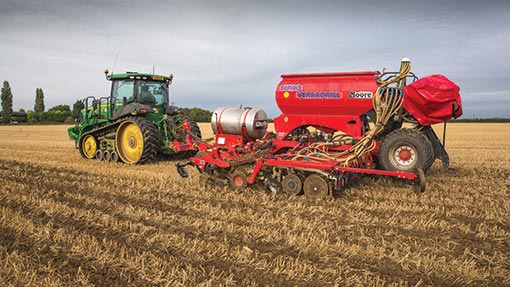Oilseed rape neonics too late to save pest-ravaged crops

The approval for two neonicotinoid sprays in oilseed rape has come too late for some growers who have lost the fight against cabbage stem flea beetles.
These new products are different neonicotinoids to those banned for use as seed dressings by the European Union, and were finally cleared late last week.
But for many growers in an East Anglian pest attack hotspot, the long-awaited clearance came after they were forced into expensive redrilling.
Essex grower Ed Ford had to redrill 25ha of his oilseed rape in early September on his farm near Chelmsford after significant damage from flea beetles in a mid-August-sown crop.
“I just wish it had come in slightly earlier, because for us it is too late, really, as we have already lost some of our crop,” he says.
He explains redrilling could cost more than £50/ha, including drilling, rolling and spraying, but one of the biggest costs was his own time.
“It has been one of the most intensively managed crops we have ever had to grow and is now proving even more costly, especially if we choose to go with a neonicotinoid spray as well,” he adds.
In Cambridgeshire, David White has redrilled 15ha of oilseed rape after already applying a pre-emergence herbicide and fertiliser on his previous crop.
Although most of his oilseed rape is establishing well, the last area, sown on 2 September, suffered flea beetle damage and he decided to redrill.
In north Hertfordshire, Paul Eaglen has redrilled 44ha of oilseed rape, using the opportunity to spray one field for blackgrass control before sowing again.
“The crops we have redrilled are coming through well, but there is still flea beetle there and the control we are getting with the insecticides is 50% at best,” he says.
The two new products now approved are InSyst from Certis for use against flea beetles and Biscaya from Bayer CropScience – cleared for control of disease-carrying aphids, but may have some effect on flea beetles.
Mark Hemmant, technical manager at distributor Agrovista, says these products could give crops breathing space to grow away from flea beetle damage, but they won’t solve everyone’s problems.
“You will not be able to go on multiple times for cabbage stem flea beetle and in the later crops that are experiencing infestations for longer, one application may not be enough,” he says.
However, there will be a benefit for growers who have struggled to see control using pyrethroid sprays and in the battle against disease-carrying aphids.
Andrew Watts in Hertfordshire is biding his time before redrilling, but admits he could lose about 25% of his oilseed rape due to flea beetle damage.
“We are going to continue to spray, but we are not going to redrill because we are concentrating on our autumn cereals,” he says.
While he welcomed the recent approvals, he says the damage has been done on his farm.
He has applied four pyrethroid sprays and a pre-emergence herbicide and may spray a neonicotinoid on some of his crop to control flea beetles.
Neonics for oilseed rape
InSyst – Contains the neonicotinoid acetamiprid and is already cleared for the control of pollen beetle in oilseed rape crops in the spring. It can now be used once in a 120-day emergence clearance period until late January against cabbage stem flea beetles.
Biscaya – Contains the neonicotinoid thiacloprid and now has an extension of use for the control of the main vector of turnip yellows virus in oilseed rape, the peach–potato aphid, and may give some control of cabbage stem flea beetles. It can be used twice in a crop of winter oilseed rape – once in the autumn to control aphids and once in the spring to control pollen beetles.
See also: Neonicotinoid field studies to assess effect on bees

